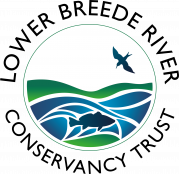Why is natural vegetation important?
Natural vegetation is critical for healthy ecosystem functioning as it:
- Regulates the flow of biochemical nutrient cycling and strongly affects soil characteristics.
- Serves as habitats for wildlife that rely on the vegetation as a source of food and shelter.
- Determines an ecosystem’s resilience to threats, such as climate change.
- Improves human livelihoods and sense of place.
What are the negative impacts of clearing natural vegetation?
Habitat & Biodiversity Loss
The Breede River has a great diversity of fauna and flora across multiple habitat types. Loss of these habitats result in the breakdown of interactions between biotic and abiotic factors. This leads to biodiversity loss which has a further knock-on effect. In time, local extinction occurs, making habitats more vulnerable and susceptible to alien species.
Soil Erosion
The majority of soil erosion occurs when natural vegetation is converted to agricultural land. Clearing and ploughing of vegetation strips the land of fertile top soil, which is then blown away by wind or washed away by rain. Soil erosion also occurs when reeds and sedges are removed from river banks. The lack of vegetation has a detrimental effect on the environment’s ability to retain and filter excess nutrients, as well as limit run-off.
What is Renosterveld?




Renosterveld is a distinct vegetation type which falls within the Fynbos Biome and is associated with the shale-derived soils of the lowlands. These soils contain clay which make them relatively fertile. The Overberg contains some of the largest and most intact Renosterveld remnants. All Renosterveld is listed as Endangered or Critically Endangered.
Unfortunately, most Renosterveld has been replaced by agricultural crops and is now highly fragmented with fewer than 50 fragments being over 100 ha in size, and just 5% remaining overall.
There are many of reasons to protect these vulnerable habitats. The great diversity of shrubs and grasses, intertwined with flowering plants of all shapes and sizes compliments the natural beauty of the lower Breede River. Renosterveld is the richest bulb habitat on Earth! These habitats are also home to many animals, which form part of a complex and delicate ecosystem, despite the fact that this biodiversity hotspot is teetering on the edge of functional extinction. Preserving the ecosystem processes such as pollination and the movement of animals across corridors and remnant patches is paramount to ensuring the survival of all the life in the Overberg wheat-belt.
Visit the Overberg Renosterveld Conservation Trust website for more details.
Please adhere to the following rules and regulations that protect our beautiful landscape
©Jacque Smit
LAWS ON VEGETATION CLEARING
Renosterveld
IT IS UNLAWFUL TO CLEAR, PLOUGH, OR ALTER ANY INDIGENOUS VEGETATION*
*The Conservation of Agricultural Resources Act 43 of 1983 (CARA) and National Environmental Management Act 107 of 1998 (NEMA) requires written authorisation from Environmental Affairs for any land development.
Failing to do so can result in fines of up to
R10 million, imprisonment or both.
Please note: Vegetation on land where the topsoil has not been disturbed over the preceding ten years is considered indigenous.
Reeds and Sedges
Under no circumstances may you remove (uproot) reeds or sedges from the river bank of your property. You may, however, trim the vegetation. Please do not clear more than 1 m on either side of your slipway and/or jetty gangways.
Reeds and sedges provide key ecosystem functions such as bank stabilisation and water filtration, as well as providing habitats for birds and invertebrate species below the surface.
Milkwood Trees
Cutting or pruning of White Milkwoods (Sideroxylon inerme) requires a license, except if less than 25% of the crown is pruned, but not for the topping of such trees, and not for new development or redevelopment (exemptions published in Government Gazette no. 773 of 27 August 2007)*.
*Under the National Forests Act 84 of 1998.
Alien Vegetation
Property owners are responsible for removing alien vegetation that occurs on their property. This includes trees such as Australian Acacias and Eucalyptus species, as well as aquatic plants like water hyacinth and parrot’s feather.
BUILDING REGULATIONS
All land use activity on privately owned property is subject to legislation in order to protect the environment. The rights of our neighbours are also protected, for example, to reduce noise disturbance.
Legislation governing land use along the Breede River is complex and falls under the mandate of various levels of government due to the estuary forming part of the coastal protection zone*.
*The Integrated Coastal Management Act 24 of 2008 (ICMA).
Take note of the following:
- Zoned agricultural and zoned residential properties have different land use rights.
- No structures are permitted below the five metre contour line (5m above sea level) on any property - this serves as the coastal management line in terms of the ICMA.
- All building developments situated within 100 m of the high-water mark and the 1:50 year flood line require an Environmental Impact Assessment (EIA).
- The construction of jetties are subject to the Sea Shore Act 21 of 1935. Application for jetties are to be made with Cape Nature, prior to construction.
- The construction of slipways are subject to NEMA and trigger a Basic Assessment Application with the Department of Environmental Affairs and Development Planning. Authorisation is required prior to construction.
- All building work is subject to the National Building Regulation No. 103 of 1977 and must be authorised prior to commencement, even if it is of minor nature.
Contact Swellendam or Hessequa Municipality before undertaking any building activity on your property.
The clearing of indigenous vegetation (>300m2), even on zoned residential property, is subject to NEMA.
CONTACT DETAILS
Lower Breede River Conservancy Trust
028 537 1296 / 064 774 3862

Overberg Renosterveld Conservancy Trust
083 551 3341
info@overbergrenosterveld.org.za www.overbergrenosterveld.org.za



